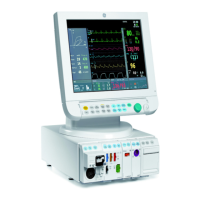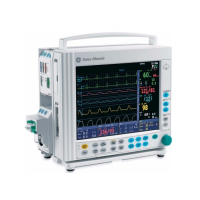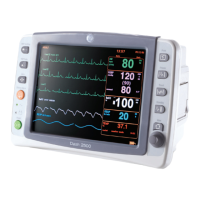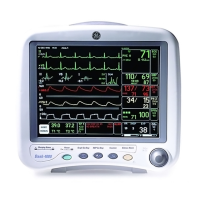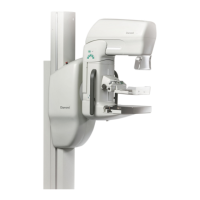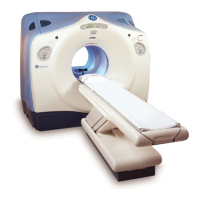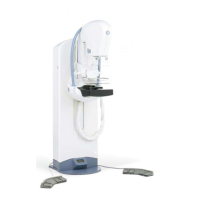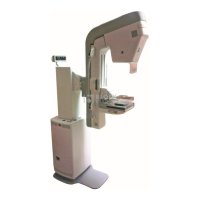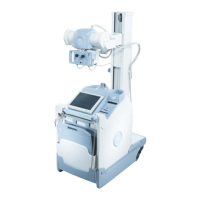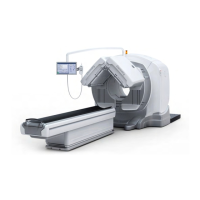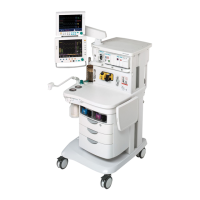
Do you have a question about the GE Datex-Ohmeda Aisys Carestation and is the answer not in the manual?
| Type | Anesthesia Machine |
|---|---|
| Manufacturer | GE Healthcare |
| Model | Aisys Carestation |
| Power Requirements | 100-240V AC, 50/60 Hz |
| Display | High-resolution color touchscreen |
| Ventilator Type | Electronically controlled ventilator |
| Ventilation Modes | Volume Control, Pressure Control, SIMV, Pressure Support, Manual |
| Gas Delivery | Oxygen, Nitrous Oxide, Medical Air |
| Power Supply | AC mains, Battery backup |
| Integrated Monitoring | Yes |
| Communication | Ethernet |
| Connectivity | Ethernet |
| Alarms | Comprehensive alarm system for ventilation, gas delivery, and patient monitoring parameters |
Details the scope of service information covered for the Aisys anesthesia machines.
Highlights the necessity of consulting User's Reference manuals for repairs.
Provides a general description of the Aisys Carestation system's capabilities.
Identifies the main physical components of the anesthesia system.
Details the components of the advanced breathing system.
Lists optional components that can be attached to the breathing system.
Describes the function of the keys and controls on the display unit.
Explains the elements and layout of the normal view of the anesthesia system display.
Provides instructions on navigating and using the system menus with the ComWheel.
Explains the meaning of various symbols used in the manual and on the equipment.
Describes the main computing units and interaction of electrical subsystems.
Details how mains power enters and is distributed throughout the system.
Explains the functions and main components of the High Performance Display Unit.
Describes the RS-422 serial communication between processors and subsystems.
Details the connections for the Display Unit and the Display Connector board.
Explains the power distribution and communication connections between these boards.
Details the overview and specific components of the Anesthesia Control Board.
Describes the electrical and pneumatic interface provided by the Ventilator Interface board.
Explains the function, subassemblies, and components of the Electronic Gas Mixer.
Details the integrated electronic vaporization subsystem for adding agent to fresh gas.
Explains the paths of gas flow through the anesthesia machine.
Covers four types of gas flow paths: ventilation, fresh gas, scavenged, and EZchange.
Lists the mechanical subsystems that comprise the ventilator.
Covers visual inspection of the equipment, components, and connections.
Details the automated machine checks for system integrity, including leak tests.
Explains the circuit leak check setting for passing leaks below 250 ml.
Describes the automated machine checks performed, including system, circuit, and O2 cell.
Details the two-step system check for gas supply, ventilation, leak, and vaporizer.
Covers checks for Bag/Vent switch, gas pressures, APL valve, and manual circuit leak.
Describes the procedure for measuring the O2% and calibrating the O2 cell.
Allows performing any combination of single checks for specific problem diagnosis.
Tests for leaks in the bellows by measuring the drop rate after filling.
Tests the functionality of the display backlights by turning them off sequentially.
Covers connecting supplies, checking cylinder pressure, and testing for high-pressure leaks.
Measures the time to fill the bellows with O2 flush, checking for proper timing and leaks.
Tests various alarms including FiO2, MVexp low, Ppeak high, and PEEP high.
Checks the operation and accuracy of the alternate O2 flowmeter.
Tests the operation and accuracy of the auxiliary O2 flowmeter.
Verifies gauge accuracy and flow rate of the integrated suction regulator.
Tests the system's behavior when AC power is disconnected, checking for alarms.
Verifies leakage current and resistance to ground to ensure electrical safety.
Outlines the three levels of the Service menu: Install/Service, Installation, and Service.
Supports hospital preferences like units, ventilator, and gas delivery defaults.
Allows configuration of graphical trend pages and default trend types.
Enables changing parameter colors, weight units, CO2 units, and pressure units.
Displays gas and agent cumulative usage data stored in non-volatile RAM.
Restores the system to default factory settings for parameters and alarm limits.
Allows setting volume conditions and CO2 humidity compensation.
Allows selection of fresh gas control styles: User, Flow, or O2%.
Enables or disables alveolar support in cardiac bypass mode.
Requires service password; supports language, gas color codes, and hardware configuration.
Requires service password; supports diagnostic tools and automated component tests.
Provides step-by-step instructions for various system calibrations.
Instructions for displaying TV data and performing Spiro calibration.
Allows calibration of flow and pressure sensors, Circuit O2 Cell, and Airway Gas.
Procedure for calibrating the manifold pressure transducer.
Procedure for zeroing the inspiratory flow valve. Not required for System Software 4.X+.
Details calibration of the inspiratory flow valve at low and high flows.
Calibrates the manifold pressure to bleed resistor flow.
Procedure to calibrate the airway pressure transducer.
Calibrates gas supply transducers by zeroing them.
Sets ventilator drive gas and altitude settings for gas configuration and machine location.
Instructions for setting the zero point for mixer pressure.
Provides a step-by-step checklist for installing the Aisys system.
Details routine maintenance procedures required for the Aisys anesthesia machine.
Specifies maintenance tasks and parts replacement for 12-month intervals.
Lists parts replacement tasks required every 24 months.
Details parts replacement tasks required every 48 months.
Provides instructions for maintaining the free breathing valve.
Tests the Mechanical Overpressure Valve (MOPV) for proper function.
Tests the pressure limit circuit's trip point at approximately 109 cmH2O.
Covers mixer outlet check valve leak test and flow verification.
Checks the accuracy and operation of the alternate O2 flowmeter.
Tests the operation and accuracy of the auxiliary O2 flowmeter.
Verifies gauge accuracy and flow rate of the integrated suction regulator.
Tests the backup batteries to ensure they are fully charged and viable.
Shows typical cable connections and routing for machines with an upper module rack.
Illustrates typical cable connections and routing for machines with a lower module rack.
Provides guidance on reviewing error logs and following appropriate subsystem procedures.
Identifies problems, causes, and actions for high and low pressure leaks.
Lists BIOS error messages and corresponding troubleshooting actions.
Addresses symptoms like no boot, white display, rotary encoder failure, and fan noise.
Diagnoses issues related to the Ventilator failing its Power-On Self Test.
Provides guidance on performing breathing system leak tests and troubleshooting flowcharts.
Offers visual guides for diagnosing system-level issues based on symptoms and alarms.
Correlates error log entries and display types with specific troubleshooting flowcharts.
Details technical alarms that exist independently of patient connection, like failed states.
Covers fault isolation for the eVap, including test results and troubleshooting procedures.
Procedure to test for leaks in the cassette or eVap connection valves.
Tests the backpressure created by the backpressure valve by monitoring flow and pressure.
Tests the eVap inflow check valve for proper function by measuring pressure and flow.
Tests the scavenger path for restrictions by measuring pressure difference.
Lists the steps and messages encountered during the system checkout process.
Provides essential precautions before replacing circuit boards in the Aisys system.
Details the procedure for safely bleeding gas pressure before disconnecting fittings.
Describes removing rear cosmetic and inner enclosure panels for access.
Provides instructions on removing the tabletop by accessing captive screws.
Details the replacement of components within the pan electrical enclosure.
Covers replacing the eVap and its components without removing it from the machine.
Details emptying and replacing parts of the Aladin2 cassettes.
Provides instructions for replacing Alt O2 flowmeter and needle valve assembly.
Details the procedure for removing and replacing the system switch.
Covers removing the Display Unit and disassembling it for component replacement.
Details replacing components in the lower electrical enclosure like Power Controller and PSU.
Covers removing the Vent Engine and replacing its subassemblies and components.
Details replacing the pipeline inlet filter, check valve, and manifold.
Covers tightening high-pressure tube fittings and replacing the primary regulator module.
Details replacing transducers for pipeline or cylinder supplies.
Provides instructions for removing and replacing the ACGO selector switch.
Instructions for cleaning or replacing the ACGO port flapper valve.
Details the procedure for replacing the Adjustable Pressure Limiting (APL) valve.
Covers replacing the bag support arm assembly and its components.
Provides instructions for replacing the machine casters, emphasizing safety.
Details rerouting the sample gas back to the breathing system.
Explains how to change the drive gas and select the correct drive gas on the ventilator.
Covers adjusting counterbalance, wrist casting, and clutch bearings for display positioning.
Covers functions of the Compact Flash card for system software and log access.
Details downloading new software versions or all software subsystems.
Provides access to Display Diagnostics, Compatibility Table, and System Download Log.
Tests display components like LEDs, speaker, backlights, and soft keys.
Tests keys and performs battery status checks, including countdown and voltage.
Displays chronological entries for every Software Download completed.
Details the service application running on a Windows PC for diagnosing failures.
Displays software/hardware revisions and subsystem status indicators.
Provides access to Power, Gas Delivery, Vent, and Vaporizer schematic diagrams.
Lists access to diagnostic screens via File, Tools, Power Diagnostics, and Subsystem menus.
Includes Preferences for display format and an Exit option.
Provides access to Communication Status, System Calibrations, and Transfer Logs.
Allows diagnostics for Power Board, Anesthesia Control Board Power, and Mixer Board Power.
Covers Gas Delivery Schematic, Gas Supply Status, Mixer Output, and Mixer Tests.
Includes Vent Schematic, Vent Status, and Vent Flow and Pressure diagnostics.
Covers Vaporizer Schematic, Vaporizer Output, and Perform Vaporizer Test.
Provides standard window manipulation items like Cascade, Tile, Close.
Includes an About option for information about the Service Application.
